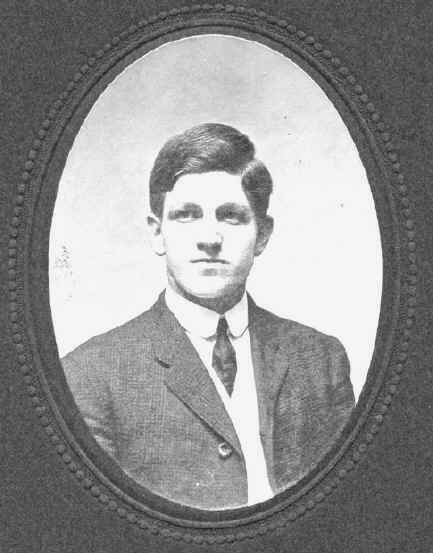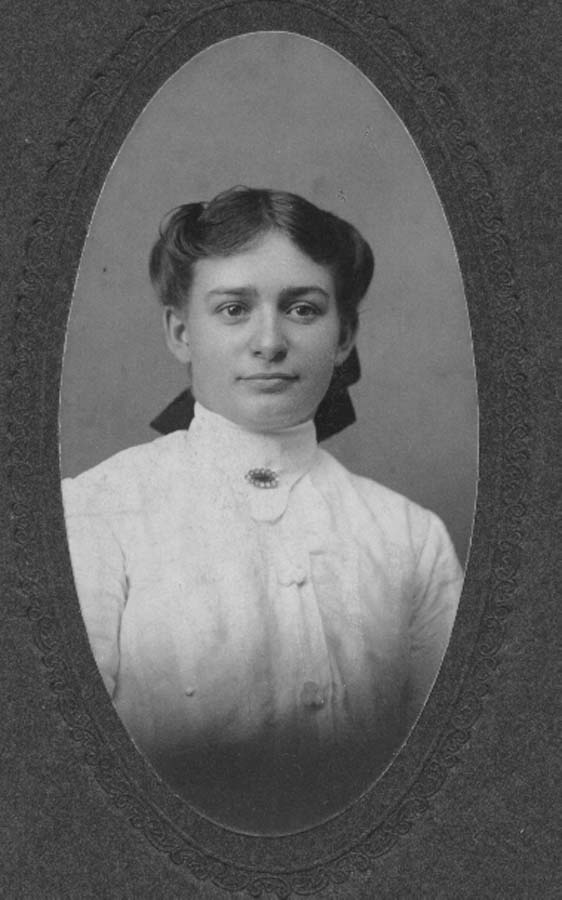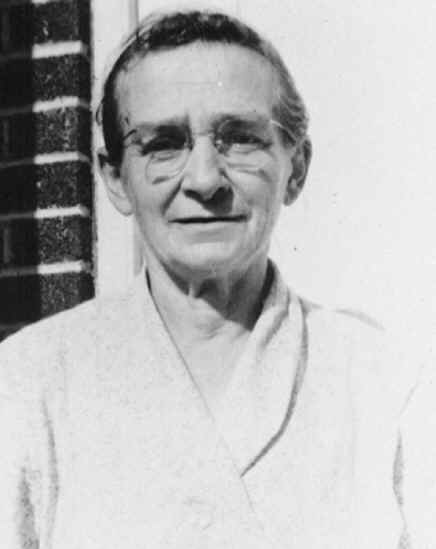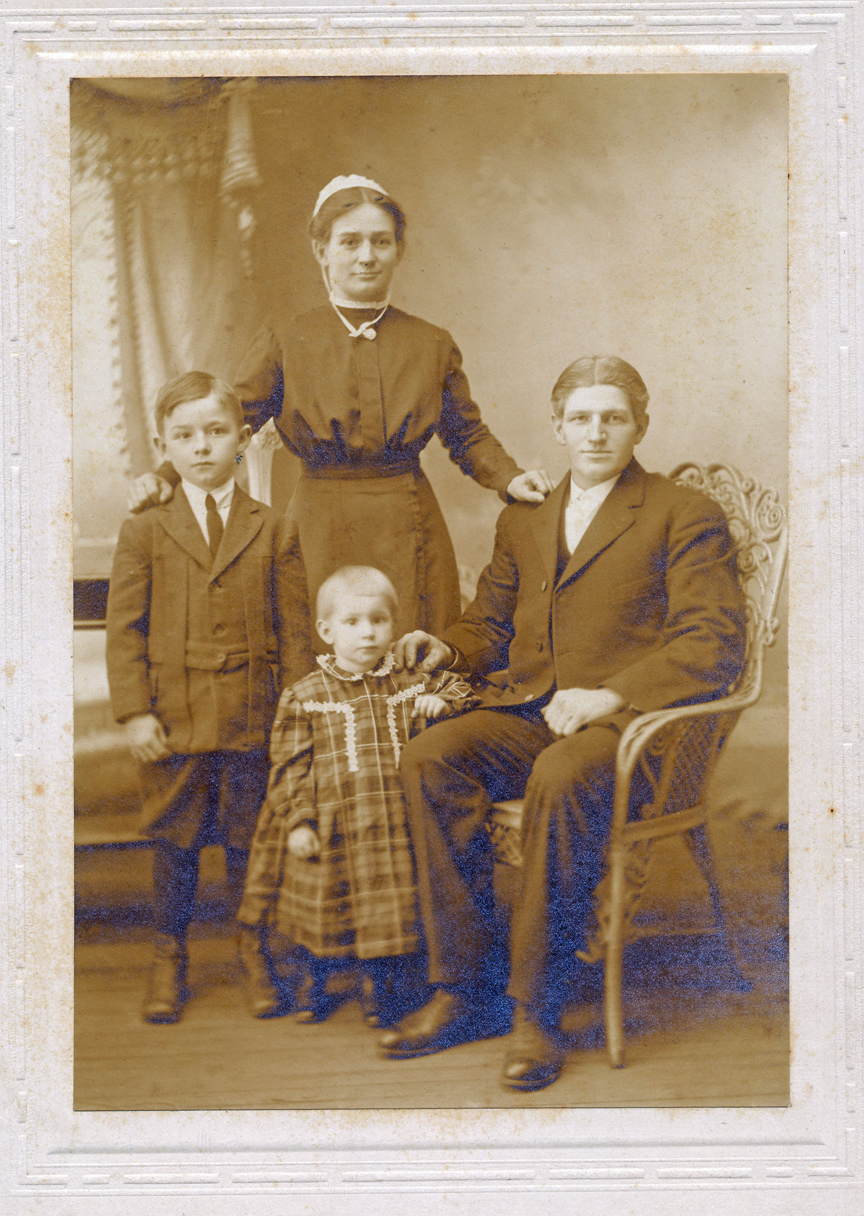

George M. Frysinger and Clara B. Schaffner

George M. Frysinger, 1885 -1949
George May Frysinger was born March 8, 1885 in Dover Township, York County, Pennsylvania. He was the son of Jacob Frysinger [8] and Susanna May [9]. About the time George turned six years of age, the family moved across the Susquehanna River to Lancaster County. His father became a tenant farmer for John Ziegler at Shocks Mill (present day Rowenna, west of Marietta). The farm was along the Susquehanna, adjoining the Pennsylvania Canal and the railroad freight line running between Harrisburg and Columbia. George remembered seeing the canal boats and trains pass as he worked in the fields.

From 1898, we have a glimpse of George as both philosopher and pragmatist in the following thoughtful essay written in his school composition book when he was 13 years old.
A Hundred Years to Come In a hundred years I guess there will be no one living that is living now. I don’t think there is any body living now that was a century ago. A century ago the people didn’t know any more how things will be now than we know how things will be in a century from now. One hundred years ago John Adams was president but they didn’t know who would be president now. And we don’t know who will be president in a century. There have been many great inventions since 1798. I think there will be more in a century and maybe some greater ones then there have been since 1798. Maybe there will be machines made to plow out potatoes and pick them up right away. And that will hang whole rails full of tobacco up at a time so that a body don’t need to hang it up lath by lath. Maybe in a century from now, the people will not use the same kind of money as they do now. And no doubt the people will be dressed differently than what they are now. And will have steam engines to plow in the fields and will take ten or twelve furrows at a time. Just a year later, George’s father died of a heat stroke while working in the fields, and George’s school days were about over. His mother, with George and his younger sister Emma (Annie), went to live with his older brother Jesse in Conoy Township. They lived on the 31-acre farm (along Route 241 near Bainbridge) that George’s father had purchased two years earlier. A cousin of George’s mother, Hiram Billet was manager of the John Y. Boyd estates near Oberlin in Swatara Township. He got George a job working as a farm hand. An old photograph shows sixteen teams of horses in line for fieldwork. Several years later the estate dairy operations expanded and George was asked to deliver milk for the Bonny Meade Dairy Farms. For about two years he delivered in Harrisburg, then began a door-to-door milk delivery route through Steelton. Through mutual friends, George met his future wife, Clara Schaffner. She was living with her mother east of Harrisburg. Efficient transportation was needed to cover the miles between their homes. On 8 May 1906, George went to J. M. Walter, a carriage dealer in Hummelstown, and purchased a brand new Jenny Lind and harness for $100.00.

Clara B. Schaffner, 1888 - 1975
Clara Belle Schaffner [5] was born on 22 Mar 1888, the daughter of Hiram Schaffner [10] and his wife Fannie Fackler [11]. Clara was their ninth child, the middle one of a list of seventeen children, four of whom had died before Clara was born.
The family farmed land along present-day Red Top Road in Lower Paxton Township, Dauphin County, Pennsylvania. Fannie’s great-grandfather, Joh. Wendel Fackler [88], had purchased the farm in 1771. The large family worked hard to raise their own food. During Clara's childhood there were usually ten at the table. In the summer, they had fresh vegetables and fruit. In the winter, their usual meals consisted of dried vegetables, corn, beans, and apples. When a chicken was killed and prepared for a family meal, Clara's portion was the second joint of one wing
Although the Schaffner and Fackler families had been in America over 125 years, their German heritage was evident in the Pennsylvania Dutch language spoken in their home. The children learned English when they went to school. Hiram Schaffner, who had received some secondary school education, chose not to teach the English at home because he wanted the children to learn it from teachers who spoke English as their native language. Consequently, the Schaffner children grew up speaking English with little trace of a German accent.
At age four, Clara began walking with her older brothers and sisters the two miles to the Oakdale school on Union Deposit Road.
Photo of Her teacher and school as it looks in 1999
Occasionally, when the weather was cold and the snow was deep, father would take them on the horse. Oakdale was a two-room school, one for grades one to four, and the other for the "high school" of grades five through eight. In later years Clara would say, "That's where I graduated." She became an excellent speller, and throughout her life she could recite poems and sing songs she learned there. One of her favorite poems was "Paul Revere."
Clara had early responsibilities on the farm. Once when she was working in the field picking up rocks and throwing them on a wagon, she fell and was caught under the wagon as the wheels began to move. Her pelvic bones were broken and failed to heal in correct position. Later, this caused great difficulty and pain for Clara in giving birth to her children and contributed to the stillbirth of a son. When her last child was due, her husband insisted that she go to the Polyclinic Hospital in Harrisburg to give birth.
Clara was seventeen in 1905 when tragedy struck the family. Her father, a sister, and two brothers died during an epidemic of typhoid fever. Several other children were just as ill with the typhoid but survived. Other siblings died of typhoid two years later. Her mother moved the remaining family to a home on Locust Lane, an area where work by the day was available. Soon, at the home of a friend, Clara met an attractive milk deliveryman.
On 24 Sep 1907, Clara Schaffner [5] and George Frysinger [4] went to the home of Rev. Thomas Patrick to be married. The young couple lived in a home near Oberlin that was owned by the Boyd Estates. Their first son, Hiram, was born there. About two and one-half years later, George was transferred to work at the big dairy barn on Bonny Meade Farms, east of Paxtang, right off the Harrisburg-Hummelstown-Hershey highway. They lived in a large house and kept three to five boarders who helped operate the dairy. A huge garden provided vegetables for the household. The 1910 census lists George, age 25, as a driver for a dairy, with his wife Clara, 22, and son Hiram, age 2.
Hiram [2] recalled, "Our daily schedule was for the boarders to get up at 2:30 in the morning to go out and milk the cows. Dad would get up about 4 o'clock to go out and bottle the milk and get it ready and get the wagons loaded for the dairy route. At about 5 o'clock they came in for breakfast. So Mother had to have breakfast ready for the whole gang by that time. Following that, of course, the men would go out and do the other barn work and Dad would leave for his milk route."
On 9 Oct 1913, George M. Frysinger of Upper Swatara Township entered into articles of agreement with William and Susan Tyson of Lower Paxton Township concerning the purchase of a 23-acre farm about two miles north of Rutherford. This property had long belonged to the Brightbill family, and had been purchased by Tyson just a year earlier.
The terms of the agreement revealed important considerations when transferring farm property in the earlier 20th century:
" . . . agree to sell to the said George M. Frysinger, all that certain messuage, tenement and tract of land . . . situate in the said Township of Lower Paxton, Dauphin County, Pennsylvania, containing twenty-three (23) Acres and fifty-seven (57) Perches, more or less . . . to convey the same on or before the 1st day of April, A. D. 1914, until the said George M. Frysinger, by good and lawful deed in fee simple, free of all liens, mortgages, encumbrances, and all taxes to be paid and including the year 1913 by the grantors . . . The said William O. Tyson is to haul at least one load of manure every three weeks from this date to February 1st, 1913, from the Good Will Fire Engine House on said farm which is to be the property of the grantee herein named, but it is understood that the grantee shall pay for said manure at the rate of twenty-five (25c) cents per load. It is understood that the hay and millet on the East end mow of the barn is the property of and shall belong to the said grantee, and the unfed corn fodder at the time of delivery of said deed shall be the property of the grantees and that said hay shall not be sold nor shall any corn fodder be sold now on the premises; nor shall any straw be removed from the premises. It is understood and agreed that the conveyance above mentioned shall include all the present buildings on the farm as well as the land; in other words, if any of the buildings should be destroyed by fire before delivery of possession, the amount of the insurance now in force and which shall be continued by the grantor until the 1st day of April, 1914, shall become immediately the property of the purchaser or such amount shall be deducted from hereinafter mentioned purchase price. . . . George M. Frysinger agrees to pay for the said premises . . . the sum of forty-seven hundred ($4700.00) Dollars, in manner, following to wit: Five ($5) dollars upon the execution of this agreement, the receipt whereof is hereby acknowledged, and the balance, to wit, Forty-six hundred and Ninety-five ($4695.00) Dollars, shall be paid on or before the 1st day of April, A. D. 1914, upon the execution and delivery of the deed of conveyance aforesaid . . ." In March of 1914, with not quite 6-year-old Hiram and 15-month-old Muriel, George and Clara loaded their things on wagons and moved to their own farm between Rutherford and Union Deposit Roads in Lower Paxton Township. Hiram recalled that the spring mud was so deep, it was questionable whether the horses could pull the wagon through. But eventually they arrived in their new home. The family used the acreage for truck farming, and George hauled the produce to his former milk customers in Steelton. Onions and beets were popular crops. One summer the family picked 500 quarts of blackberries. Sold at 10 cents a quart, the income was sufficient to pay the interest on the mortgage on the farm for that year. George also raised chickens to produce eggs for sale in Steelton. Interested in improving egg quality and increasing production, he began buying hatching eggs. Hiram recalled an order of 100 eggs for $75 and another $15 for 15 eggs from Grand Rapids, Michigan. When these eggs were hatched, distinctive web punches identified the chicks. Later, numbered leg bands were placed on each hen. By trap-nesting it was possible to identify the source of each egg. The eggs were then weighed and graded so that the best layers could be identified. These were cross-bred to further increase production. Setting up incubators in the cellar of the farmhouse, George began hatching and selling baby chicks.Nonproductive hens and the roosters were killed and dressed every Friday morning and iced down until sold in Steelton on Saturday. During World War II, they sold as many as 100 chickens each week. George, his children Hiram, Muriel, and Harry, and the grandchildren continued the Steelton route for over 50 years. George's special talent for mental arithmetic was useful in this retailing business.
Clara worked with the chickens, milked the cows, tended the garden, and raised flowers. She was particularly fond of the peonies, calla lilies, and lilies-of-the-valley in her well-tended flower beds. Each spring she would study the colorful seed catalogs, carefully selecting the few flower seeds or bulbs that could be ordered along with the seeds for the vegetable garden. Although George was generous in providing these extras, Clara was at times annoyed that she "had to ask for it." In 1913, near Oakdale, George and Clara were baptized and became members of the Big Swatara congregation of the Church of the Brethren. After their move to the farm, they became active in the nearby Paxton Church, one of several meetinghouses in the congregation. On 14 Dec 1914, it was noted in the church minutes that Geo. Frysinger had been elected treasurer of the Paxton Sunday School. The following year he was assistant superintendent, and in 1919 became superintendent, a position he held for most of the rest of his life. In 1920, he was asked to be Missionary Solicitor. Soon he was also serving on the Sunday School and Missionary Committee for the congregation, the Welfare Board, and the Paxton Cemetery Board. He also taught the Sunday School class for elementary school age children at Paxton. Clara had a strong alto singing voice. She and her oldest sister Sallie had learned to read shaped-note music at the singing schools occasionally held in the churches. Clara led the singing in the Paxton Church of the Brethren and was appointed chief song leader in 1921. Clara taught the young children's Sunday School class for many years and was also instrumental in making the interior of the church more attractive. In December, 1931, she wrote a letter requesting the Big Swatara church council to consider papering the Paxton church, installing new blinds, and getting a better lighting system. George and Clara frequently attended church services, Love Feast, and Council Meeting at the Hanoverdale Church of the Brethren. In the early years, the seven-mile-long trip was with horses and carriage. They regularly took neighbors with them to church. In fact, when they bought their first automobile, they chose a large seven-passenger model so they could continue to transport people to church. The decision to buy a car was a big one. In the spring of 1919, George said that if they got 35 bushels of wheat to the acre that season, they’d buy a car. They got the wheat (a good yield in those days), and they bought their Chevrolet from Miles Shope, the husband of Clara’s sister Becky. Although Clara is remembered as the singer in the family, George also enjoyed music. On a Sunday afternoon, he liked to have his daughter Muriel play hymns on the piano and he sang along with the melody. When asked if he sang tenor or bass, he quipped, "I sing also." And it was a treat for all when George relaxed by playing his harmonica. Clara was especially close to her sisters Becky and Sallie. They liked to sit together on the "women's side" in church and harmonize their voices. The sisters also worked together and helped each other with major chores. Muriel remembers Aunt Becky and Aunt Sallie helping Clara cleaning house, picking strawberries, boiling apple butter and butchering—with the conversation switching back and forth between English and "Dutch." Clara also kept in touch with her grade school girlfriend Amelia Rhoads, known to the family as "Aunt Meal". Clara generally stayed pretty close to home, but in 1919, soon after their first automobile was purchased, extensive preparations were made for a ride all the way up above Sunbury to visit neighbors who had moved to Columbia county. In 1938, with her sister Sallie, Clara made her first trip by train to the Church of the Brethern Annual Conference at Lawrence, Kansas. Sallie was a seasoned traveler, so with confidence Clara decided she could go along even that far West of the Mississippi. She said that it seemed difficult to believe that the moon shining in her window in Kansas was the same one that shone on her at home. Clara cooked on a big black iron wood- or coal-burning stove in the corner of the farm kitchen. One of her specialties after the fall butchering was "pig stomach." She filled the membrane with sausage and potatoes and roasted it to perfection. She was known for her large, soft cookies—molasses, oatmeal, and, best of all, the sugar cookies. Clara raised popcorn in her garden and popped it in a black wire shaker that she held over the cook stove. To the delight of her grandchildren, when the corn was popping furiously, she would flip the lid open and let popcorn fly all over the kitchen! Clara loved to read, and the family enjoyed having her read aloud to them. Into her later years, she nursed a dream of writing a book about her life experiences. She dreamed of her children receiving a college education. Hiram had early memories of Elizabethtown College: "When they had cleaning days at college, we'd walk over to the trolley car at Rutherford Heights, take the trolley to Hummelstown, transfer to the Hershey car, transfer to the Elizabethtown car, and go from Hershey to Elizabethtown, get off at the Elizabethtown square and walk out to the college with our buckets and dust cloths and help with the cleaning." On 24 Nov 1930, George wrote his will. His primary concern was that money be set aside for the education of his younger children, Muriel and Harry. The balance of his estate was to be left to his wife Clara. His older son, Hiram, who had just graduated from college, was appointed executor. The wirnesses were close friends, Clara's first cousin and his wife, William and Emma Horst. When George was in his 50s, he suffered a series of strokes that led to increasing disability. His son Harry assumed responsibility for the farm work. The man who had been so energetic explained to the grandchildren that he was just getting "lazy." He enjoyed lying in the hammock under the big tree at the side of the house, with the grandchildren playing around him. George gradually relinquished his many responsibilities in the church. A letter dated on 8 Mar 1947, his 62nd birthday, was sent "To the Big Swatara Church in Council: Please accept my resignation as a member of the Welfare Board as I am no longer able to serve actively." The minutes noted that "Bro. Frysinger’s resignation was accepted." George became bedfast, and Clara became his full-time caregiver. He lost the ability to speak, but he still could laugh! It seemed at times that he was laughing at himself and his predicament, and that laughter brightened the days. George died on 6 Apr 1949 at 64 years of age. As was the custom, the funeral director prepared the body, but visitation was in the parlor at home. Friends came to call on Saturday evening and the funeral was at the church on Sunday afternoon, April 12. The pallbearers were his lon-time friends and neighbors, Guy Miller, John Manherz, James Nace, Leon Willow, Joh Kauffman and Jerry Smith.George M. Frysinger [4] was buried in the Church of the Brethren cemetery in Hanoverdale, Pennsylvania.
George is remembered as a kind , calm and patient man. He was 5'8" tall and stocky build. His thick auburn hair turned white by the time he was in his early 30's. He loved his family and his church -- and his chickens.After George's death, Clara continued on the farm helping her son Harry to raise chickens. Later, after Harry married, she sold the farm to him, and moved to an apartment in Hanoverdale. Just across the street from the church, she enjoyed many church activities and visiting friends. To all she was known as "Grandma Frysinger."
Clara was a short, small-featured woman. Barely 5'2" tall, she was a measuring standard for her grandchildren who gleefully surpassed her in height. Clara had gray eyes and dark brown hair with only streaks of gray as she aged. In her 60s, late-onset diabetes developed. With typical determination, she altered her diet to control it. She was a well-disciplined, energetic, and feisty little lady.

Clara Schaffner Frysinger in 1958
Photos of Clara Schaffner Frysinger
In January, 1972, Clara was riding with Harry and Fannie Etter and Becky Shope to visit their sister Sallie Schaffner who, at that time, age 98 and suffering from dementia, was in the State Hospital in Harrisburg. Their car was struck and Clara suffered brain damage in the accident. She never recovered sufficiently to return to her apartment and live a normal life. She spent several years in a nursing home in Harrisburg and died on 12 Jan 1975 at age 86. She was buried beside her husband in the Hanoverdale Church of the Brethren Cemetery.

Hiram, Clara, Muriel and George Frysinger
Children of George Frysinger [4] and Clara Schaffner [5]
1. Hiram James 11 Apr 1908 – 20 Aug 1997 m. 1st Irene K. Royer m. 2nd Miriam Wenger b Born Oberlin, Pa. d Hiram died in the Lebanon Valley Brethren Home, Palmyra, Pa. He was buried in the Church of the Brethren Cemetery, Hanoverdale, Pa. m Hiram married Irene Keller Royer, 6 Feb 1909–20 Mar 1971, on 24 Dec 1930. They had five children: Galen, Anne, Faye, Roy, and Carl. On 18 Sep 1971, Hiram married Miriam Frantz Wenger, 29 Mar 1908–14 Jan 1992.2. Muriel Amelia 9 Dec 1913 – m. 1st Lawrence Hoover m. 2nd Harry Saylor b Born Paxtang, Pa. d m On 22 Sep 1934, Muriel married Lawrence Hoover, 11 Mar 1911–30 Jul 1939. They had three children, Marie, Joyce, and John. 2nd, on 26 Jun 1943, Muriel married Harry Saylor, 20 Aug 1912–27 Dec 1965.
3. William stillborn on 15 May 1919
4. Harry Marlin 15 May 1925 – m. 1st Patricia Stankovich.
m. 2nd
Barbara Sivigliab Born Harrisburg Hospital, Harrisburg, Pa.
d m Harry married Patricia Stankovich on 7 Jun 1953. They had two adopted daughters, Cheryl and Linda. 2nd, Harry married Barbara Siviglia on 17 May 1988.
![]()
.Return to Galen's Father's page
![]()